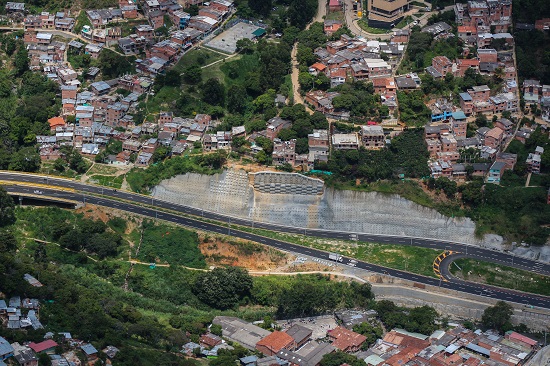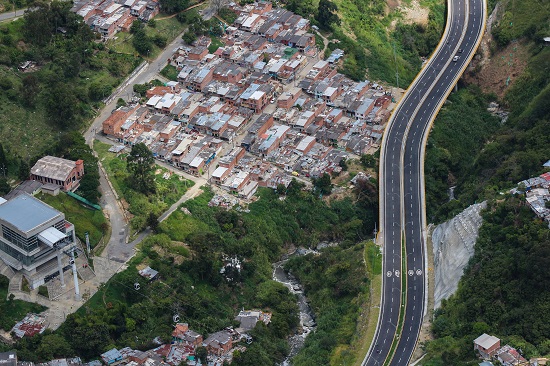
It is 4 years ago now that we submitted a bid to the Department of Antioquia in Colombia for extension of the Carrera 80 dual carriageway. This project was a key part of the local authority’s Comprehensive Urban Plan for improving the connection between Medellin and the Atlantic. What was significant about the project was that construction would be carried out in one of the poorest areas of the city, known as the Cuenca Media de la quebrada de La Iguaná, or middle course of the La Iguaná creek, making it a territory of opportunities for its citizens.
Civil infrastructure projects are usually highly technical processes with usually no participation of the local population around it. But when construction started on this road, the strength and the expectations of the community and its leaders regarding the project created a lasting impression.
And so it was decided that the project would not only cover construction of a highway, but also the construction of a Community.
How can you build a highway with engineers and the Community together? A territory of opportunities
In one of the initial meetings, my first question to the community and some of the leaders attending was:
- Do you know what the project is about, and what is going to be built?
The people looked at me rather incredulously, as though thinking: Why does this woman ask such a silly question?” The answer was clear:
- The road joining Medellin and the Atlantic coast is going to be widened into a dual carriageway, and this will give us the chance to make the area a space of opportunity for those of us who live here.
This project is therefore not only about building a road, it is a commitment to the development of the region and the transformation of the territory, meaning it is basically a social project. The implications of an infrastructure project on the territory around it are evidenced here.
The challenge: to integrate the community in construction
The dual carriageway between Carrera 80 and the tunnel to the west fulfils one of the dreams of the Antioquia community: having a connection with the Urabá region, and thus with the rest of the world.
Achieving this aim has involved thinking, designing and re-designing the project to find the best space on which to build the road. More than 20 years of thinking and generating expectations, defining the best land on which to build, identifying the territory to be crossed and obtaining the necessary resources.
La Iguaná, its people and their dreams
The territory chosen for the project is not empty. Indeed, it is home to large numbers of people who settled here when they came to the city from rural areas, in search of opportunities or fleeing from violence, something which has unfortunately marked this country for decades.
We know the history of La Iguaná through memory workshops, through conversations with residents, and talks with local leaders. The territory takes its name from the creek which cuts through it, and which over the years has created emergency situations, but it has also been a useful resource, when its waters were clean and bathing was a plausible activity, or when it was used for washing clothes when there was no other piped water provision.
The area is also a point of transit for the transport of goods to the west of Antioquia. And improving these transport links is precisely the dream to be fulfilled. Dreams of development and contact with the outside world.
The integration process
Building this 4.1 km stretch of road, in an area populated by highly vulnerable communities, was a challenge both for the local authorities and for the Ferrocol Loma Hermosa Consortium (comprised by Ferrovial Agroman and local building company Colpatria).
In order to bring together all the interested parties (local authorities, the Ferrocol Loma Hermosa Consortium and the community), a Committee for Community Participation, known as COPACO, was formed. This encouraged participatory dialogue between the parties, and effective public scrutiny and community participation in each of the proposed activities, such as: site visits, training sessions in emergency response and tree planting, among other leisure and learning opportunities. There were environmental plant nurseries, and also older persons sharing their experience, mothers from the community, essentially anyone who felt affected in their daily life.
New opportunities for the community: houses and employment
The project began with the resettlement of the population, by buying the homes of close to 1600 families (some of which were made of wood or cardboard) who were resettled in an area set aside by the municipality for social housing. The population that was not resettled will nevertheless benefit from the social, economic and spatial changes that the road will bring about, and the real opportunities that these will create.
Another positive aspect was the participation of the local population in the hiring process for actual construction work, and in creating work security and decent working conditions. Female community leaders played an important role in the hiring process, acting as liaison persons, as social assistants and road controllers. Their experience and knowledge of the region and its requirements, and their links with the project in their capacity as leaders, have facilitated smooth relations with the community.







There are no comments yet